Updated: 6-27-2022
When a golfer starts coming too far from the inside and under the plane, a multitude of bad shots are the result that can turn a day at the course into a drudgery of "Army Golf" - left, right, left, right.
Three shots are typically the result - the push, the snap hook and the dreaded shank.
All three of these shots are extremely closely related and are typically considered a "better" player's miss because this more "advanced" golfer has learned to approach the ball from the inside and can often begin to struggle with a too inside to out golf swing, which is just as devastating as the dreaded over the top slice.
However, tell a better player that his big snap hook is because he's such a good player and I can assure you he won't agree. Having a golf swing that is too much inside to out and just as frustrating for the better player as a severe over the top slice is for the higher handicapper.
Unfortunately, this fault in the golf swing is caused by a multitude of good things happening in the swing, but that are often overdone or not quite done correctly.
But specifically, in this article I'm going to discuss some terrible golf swing advice that you've no doubt heard a million times from an instructor or friend with good intentions.
The saying that you should turn your chest to the target is horrible advice for numerous reasons, but if you're swinging the golf club too much from the inside, it will make it much worse. How?
The reason is that your arms will simply become more stuck in the downswing as your arms simply can't keep up when being pulled by your rotating chest.
If you have already found yourself hitting hooks or big blocked shots, heeding the advice of turn your chest toward the target will lead to many blocks, hooks and even shanks. But why shanks?
The simple answer is that you are obviously already coming too far from the inside and need to get the club working back to the left after impact in order to get the club to work on an arc, taking the hosel out of play.

Feeling as if you are extending your arms down the target line or feeling as if the club "works down the line" longer will exasperrate your swing fault and cause you to have a severe in to out path.
In this video, I discuss and demonstrate how to get the club working back around to the left through understanding how the left arm remains connected to the upper torso and must be allowed to FOLD, that's right FOLD - not extend, in order to get the club working properly on plane and on the proper arc.
At first, this will feel as if you have a very narrow arc and are hitting a fade through the impact area if you are used to releasing down the line and then flipping your hands to square the face.
But fear not, this tight arc is the proper feeling and, in fact, is a MUST for the better player to control the plane and path of the golf club.
You will see many of the drills come to new life after watching this video.
The Bucket Drill, the One Legged Drill, the Half Shots Drill and many others will begin to take on new meaning as you finally begin to understand what causes these awful hooks, blocks and shanks and you will finally understand the simple cure to fix all the problems once and for all! Keep in mind, this is only for golfers who tend to come too much from the inside.
If your divots are steep and already pointing left, this video is NOT FOR YOU!
Video Transcription: Coming Too Far From the Inside
We're talking about an interesting concept today, and it's something that the average golfer doesn't struggle with, or that they strive to struggle with.
That is, coming too far from the inside at impact. Let's first define what that is, exactly. If I were to put a ball this way and look down the line, you can imagine that this is my imaginary target line - basically straight and down. You can almost see that this would be my target line. That's where I'd be trying to send the ball.
If I were to swing, to bring the club down and bring this club - now you can see it's underneath my forearm; it's coming in, this is what we would call too far from the inside or underneath the plane. As I come through, my club is actually approaching the ball from too in to out of an angle, or too far from the inside, so I would actually swing out to the right of the target line.

Coming down under the forearm (left), too far inside (center), in to out at impact (right)
Now, we know one of the key concepts in the Rotary Swing is swinging left. This is important, to bring the club back out in front of you, but we're going to talk more in detail about that.
Basically, if I'm swinging too far in to out, I can push the ball well right of the target. I can flip my hands over and send it sailing left of the target. It's very easy for me to hit it fat. It's very hard for me to catch it clean, and it's nearly impossible to consistently start the ball off on line.
Believe it or not, you don't have to swing perfectly down on the target line, or perfectly have a square path with a square face to send the ball down the target line, because the club face angle will help you manipulate that.

Coming down on the forearm plane (left), square into impact (right)
You can come a little bit from the inside with a little bit of a shut face, and the ball will actually fly very true. It won't look like it has much curvature on it at all.
But in an ideal world, what we want as we're coming down is we're bringing that club shaft down on that forearm plane, square coming in more on top of the ball. This allows us to catch it clean instead of coming way from the inside. You can see I can hit way fat behind it. It's more on top of the ball, and then immediately moving left.

Driving the right shoulder over the left big toe
The trick is, how does that happen?
One of the key aspects that I talk about, or one of the key swing thoughts I give a lot of golfers in my lessons is taking that right shoulder - this is for a Rotary Swinger - taking that right shoulder and feeling like they're driving it over their left big toe.
Now, if this is overdone - if you don't have a transition - you can see that I could easily bring the shaft out too far out in front of me and I'm actually going to start to come over the top. That's a bad thing, so it's a balance.
You've got to have a good transition, so this is me setting my weight onto my left side. For you guys wondering, "How do I get that shaft down on my right forearm?" this is it. Watch. If I go from here and I set my weight onto my left side and do nothing with my arms, where's that shaft? It's right on my right forearm.
If I don't settle my weight onto my left side and I just rotate, the club's way out above my forearm. This is where a lot of times you guys will find yourself either here where it's too steep, or a little bit above that right forearm.

Settling weight on the left (left), versus rotating without shifting (right)
It's simply a matter of not doing anything with your arms, settling into that transition, and the club automatically comes right down on plane, every single time.
I'm settling my hips. From face, on, all that move is, is this. You can see that I didn't really over-use my shoulders or let my head move forward, or over-use my arms. My arms are very passive. Settle in here, and then keep rotating through.

"Over the top" brings the club down on plane
To get back to this topic, what I want to feel is A, either that as I settle in I start to really feel my right shoulder come over the top feeling. You can see that that brings the club down on plane. That's my shaft plane at impact, and that's the plane I want to bring it down on.
Now I can immediately, if I keep driving that right shoulder through, I can bring the club what we call "back out in front" of us. What that means is, if we look at it from face on, at some point that club has got to get back out here at impact. It has to get back to the ball.
Of course in a Rotary Swing we talk about keeping our arms passive and keeping them back. At some point, they're going to release back out in front of the body. They have to, to make impact.
As we talk about that right shoulder feeling, I settle onto my left side, my arms are soft, and then I'm rotating that right shoulder over. Now the club has been brought back out in front of me. But from this position I can still make a mistake and stand up, and that will shove the club out, down the target line and it won't get it working back to the left.

The left arm stays connected to the chest
What I have to do, after that feeling of driving my right shoulder through it, is that my left arm has to stay connected to my chest and be allowed to fold. This is interesting, because a lot of times in conventional golf instruction you're told, "Extend your arms down the target line."
Great advice for somebody else - a two planer or even a Rotary Hitter - not for a Rotary Swinger.

Extending the arms down the target line - don't do this
If you look down the line and I bring this ball back in here, if you were to make a great swing and then think about extending your arms down the target line and shaking hands with the target, notice that that motion has stopped your body rotation so you can no longer turn, and you're extending your hands down the line - you're actually swinging in to out.
For somebody who fades and slices the ball, that can actually be relatively a good feeling, but you have to come from the inside to begin with. Understand that for a Rotary Swinger who's coming too far from the inside, this is just going to make that 10 times worse.
The key here, as I mentioned, is to stick a head cover under your left armpit, or just stuff your shirt under there when you're playing. Feel like your right shoulder is driving through, and then let that left arm start to fold back up.
Keeping that left arm extended is just going to continue to make this problem worse. It's going to get your hands driving farther out, away from your body. You're not going to get your hands allowed to work back left.

Keep the left arm connected
The greatest way to learn how to do this is with chip shots. If you've watched that low, little spinner chip shot, that's one of the things that happens in that video - that left arm folds back up. It stays connected to my torso the whole time.
See, if this left arm stays out in front of my chest and is never allowed to stay connected and release back around to the left, then that gets that whole in to out motion, where I'm leaning back and I'm shoving the club down the target line. This will also cause shanking.
Here, a little chip shot; my left arm, you can see, is staying connected, and that allows me to rotate better. It allows me to continue rotating through the shot, rather than swing my arm down the line.
The second thing - there are many reasons that cause this in to out motion, and it's impossible to go into all of them at once, but I'm going to go into another one here - that is, looking down the line again, if this is where I was at address...

Standing up into impact makes club move in to out
Pretty much every Tour pro on the planet, from address to impact, their shaft will be a little bit higher. There's lots of reasons for that.
We won't get into it now, but basically if you get too high above it and you stand up into impact, watch what happens to my club. It's going in to out again. My shaft is going out this way.
When you look at your swing and you see that you have a good posture at address, and then you're here at impact, you're coming way from the inside again. What's actually causing this, apart from you standing up is that your hands are getting too far out in front of the ball.
I posted a little blurb on the Forum showing this because, from face on, this looks like a good impact position, but the truth of the matter is that my shaft is actually higher than it was at address, and that's causing me to come from the inside too much.

Shaft is higher than address
This is an exaggeration here, but as it's coming too far from the inside my hands can't get that release back around, let that little left arm fold motion happen, and that's pulling the club back around. If my hands are way out here, I'm coming too far from the inside again.
There's a balance point between having this nice flat left wrist, but letting everything release so that left arm is bending back around.
For a Rotary Hitter, things are a little bit different and we'll talk about that in a separate video, for guys who come too far from the inside.
Know that as you're coming through into impact, that shaft should come into a similar position, but then as long as you let that left arm fold you can see that my path will come back around and I'll have more of a square or slightly in to in path, or even slightly more on top of it, where your divot starts very square and then works pretty immediately to the left.
Keep that connected. Keep that left arm connected to your body. Let it fold and work around. Think of your arms as swinging around your body. That's part of the key of keeping them soft, is that this will naturally happen as long as you keep that headcover in there.

The club's path comes back around to the left
Now, you can rotate really well and then let your headcover fall out - you're going to swing in to out. You're going to have these big, sweeping hooks. If you keep that headcover in and rotate, that's going to keep you connected. It's just a matter of staying connected, doing the fundamentals right, and that will bring the club back around.
It'll feel a little bit more over the top for you, likely, if you're used to disconnecting and coming way from the inside and blocking your hips out to the right. You're going to stay in your posture, get that right shoulder over your left big toe and get that left arm to fold, and you should see that you're coming down more on top of the ball, getting cleaner contact, and your divots are going to be a lot more square. If you see your divots going out to the right, you really need to pay close attention to this video.
Watch part 2 now to see how you're moving your body in the opposite direction of the pros!









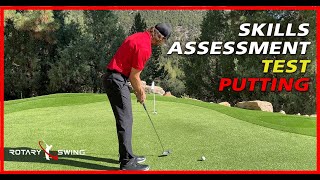



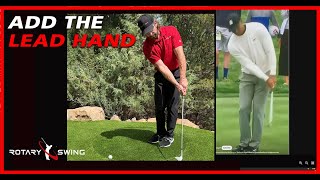











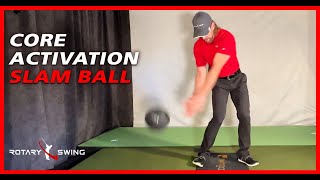





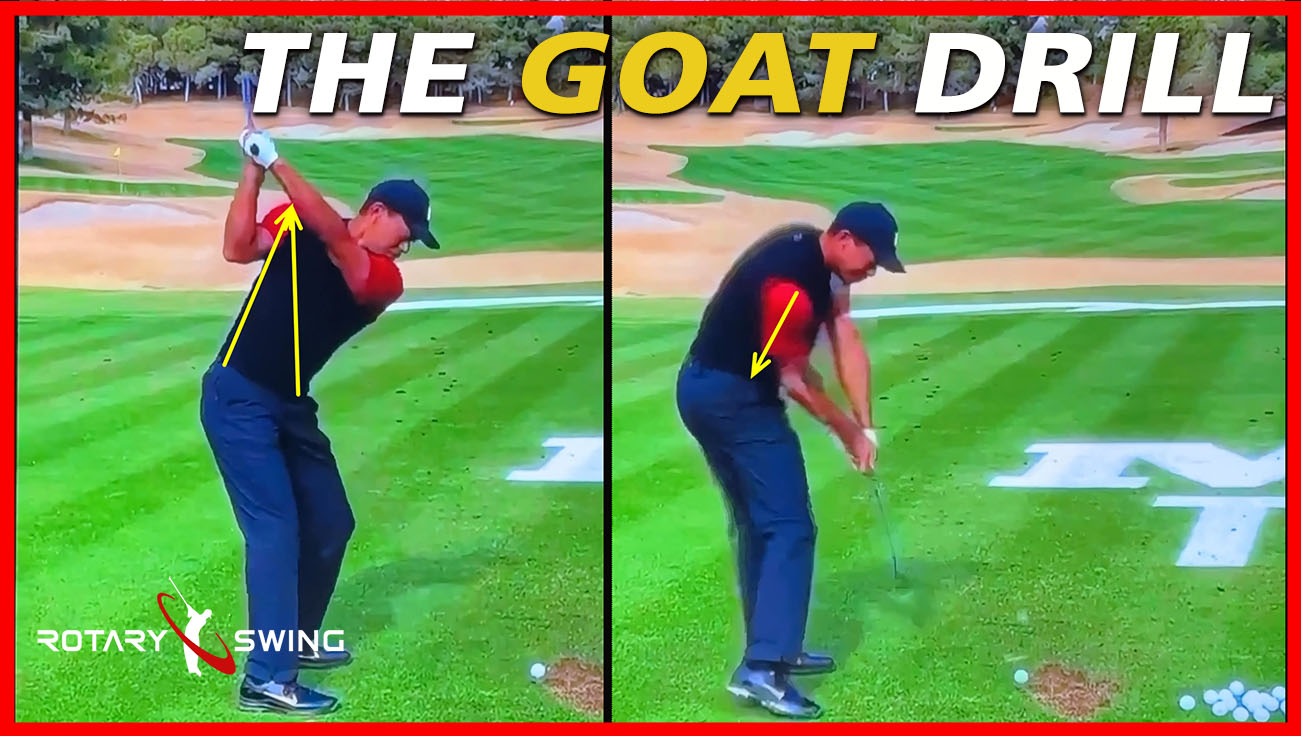


















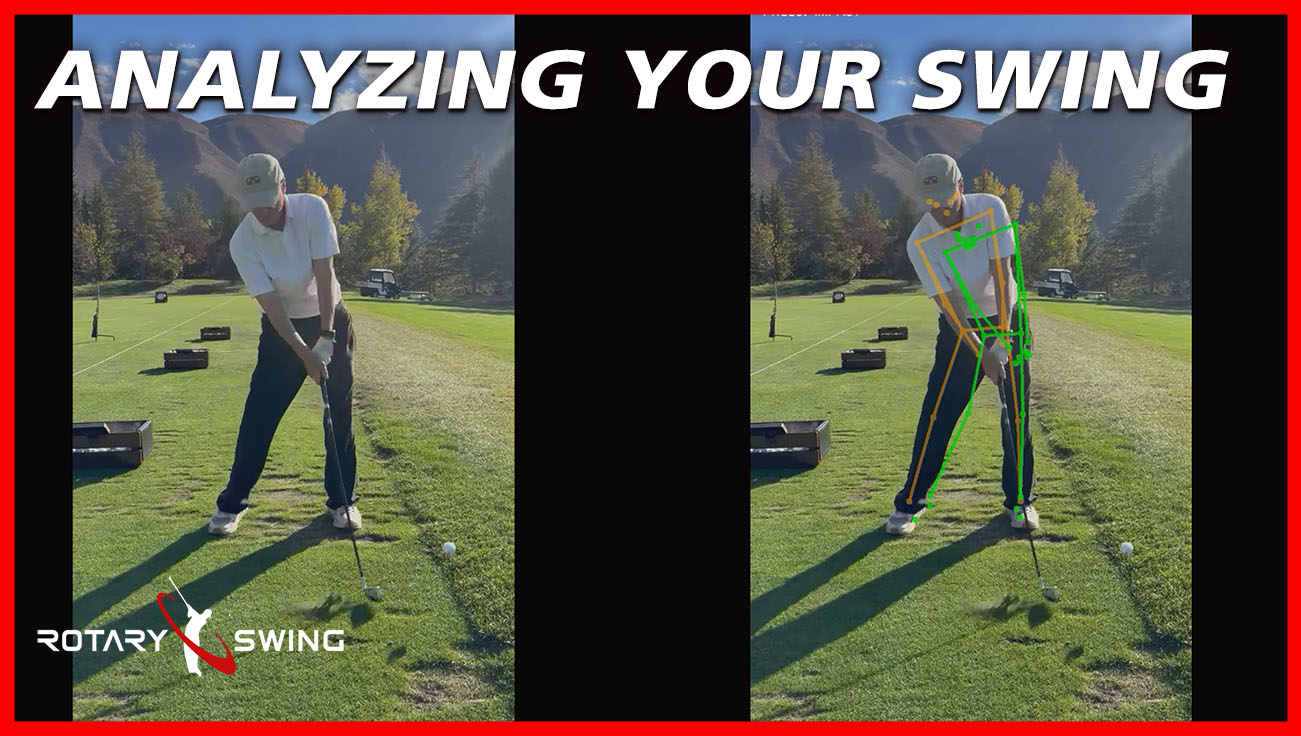








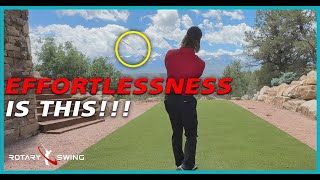
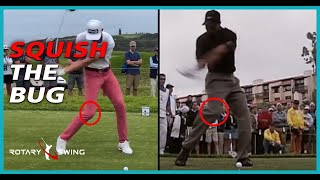











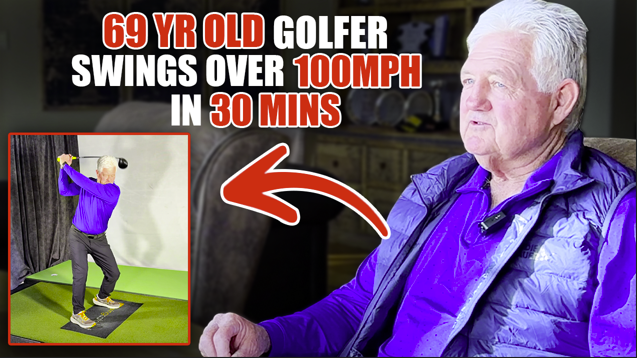





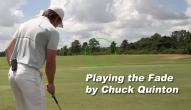











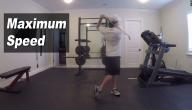

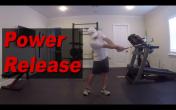

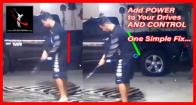
















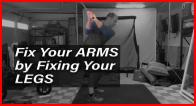










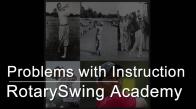




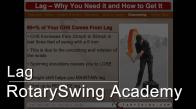



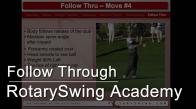


























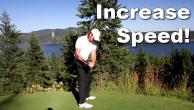




















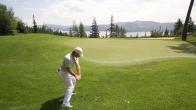





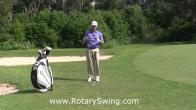



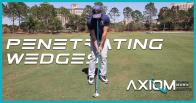





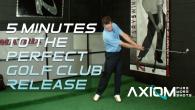





 Coming down under the forearm (left), too far inside (center), in to out at impact (right)
Coming down under the forearm (left), too far inside (center), in to out at impact (right) Coming down on the forearm plane (left), square into impact (right)
Coming down on the forearm plane (left), square into impact (right) Driving the right shoulder over the left big toe
Driving the right shoulder over the left big toe Settling weight on the left (left), versus rotating without shifting (right)
Settling weight on the left (left), versus rotating without shifting (right) "Over the top" brings the club down on plane
"Over the top" brings the club down on plane The left arm stays connected to the chest
The left arm stays connected to the chest Extending the arms down the target line - don't do this
Extending the arms down the target line - don't do this Keep the left arm connected
Keep the left arm connected Standing up into impact makes club move in to out
Standing up into impact makes club move in to out Shaft is higher than address
Shaft is higher than address The club's path comes back around to the left
The club's path comes back around to the left
